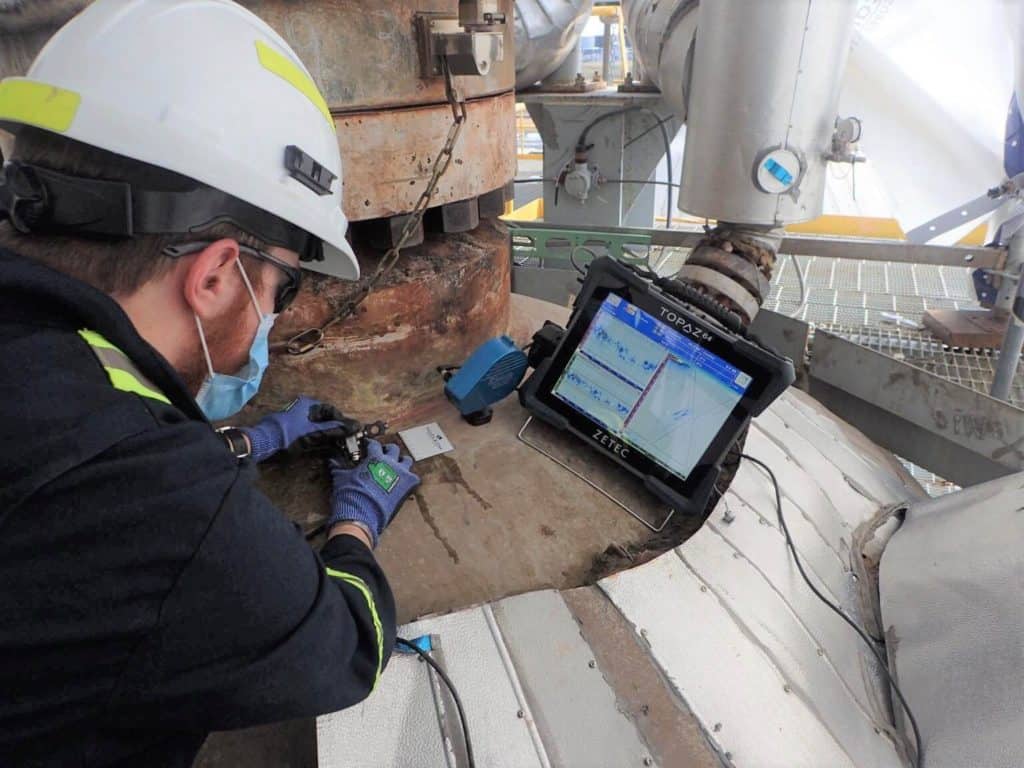Ultrasonic Testing Overview: A Comprehensive Guide to UT

Ultrasonic nondestructive testing (NDT) is a method used to characterize the internal volumes of materials. It works by propagating high-frequency sound waves well above the range of human hearing throughout the material. It can be used to detect flaws and discontinuities in metals, composites, and other materials.
High-frequency sounds travel through a uniform medium until they reach a discontinuity that reflects them back—such as air or fluid at the other side of the material—or incongruity in the matrix of the material. These reflected waves can be resolved into visual images that allow an ultrasonic testing technician to see flaws in the material, determine if corrosion is present, or detect corrosion eroding the thickness of the material. Ultrasonic testing works well for contiguous materials like metals, but not as well for materials where discontinuities are part of their normal makeup like wood, wood composites, or paper materials.
The Types of Ultrasonic Nondestructive Testing
The type of ultrasonic testing depends on the high-frequency sound wave used during the process. The direction of a beam of sound may be directed in different ways, the testing object may be immersed in a medium, and the configuration of ultrasonic transducers may differ between NDT types. Some common variants of ultrasonic testing are:
- Straight Beam: Straight beam ultrasonic testing uses a beam of sound perpendicular (at an angle of 90 degrees) to the material being tested. The sound bounces back from the far side of the material, or dissipates. The reflections are translated into an image for the technician to analyze.
- Angle Beam: Angle beam ultrasonic testing is similar to straight beam but the beam of sound is projected into the material at angles of various degrees and moved back and forth to test the full volume of the material. This allows the imaging of discontinuities that may not show up from a single perpendicular angle.
- Immersion Testing: This form of ultrasonic testing is primarily used in manufacturing. The material undergoing ultrasonic testing is immersed in a liquid. The sound is transmitted from the transducer to the material and reflected from the surface back through the liquid. This creates a strong signal that can be used to detect very small flaws.
- Phased Array: A form of ultrasonic testing that sees heavy use in the inspection of long seam welds, generic welds, and many other weld types as well as corrosion mapping. A phased array technique involves the use of multiple element probes activated individually to generate sound waves with discrete timing. This allows adjustment of the refracted beam angle and focal distance. It is very cost-effective as it allows for single-pass NDT testing.
- Time of Flight Diffraction (TOFD): This type of ultrasonic testing is used predominantly in weld inspections with the ability to measure crack sizes more accurately. Typical ultrasonic testing measures the reflection of high amplitude waves. Time of flight diffraction measures lower amplitude waves as well and uses the combined waveforms to provide a complete image.
- Total Focusing Method (TFM): An advanced phased array imaging technique and the most commonly used advanced focusing algorithm. The process results in nearly ideal focusing in each point of an image, and this improved image resolution can allow for better characterization and sizing of challenging damage.
- Guided Wave: Guided wave NDT is used for the inspection of elongated materials like piping and is frequently used during routine NDT in the oil and gas industry. It propagates ultrasonic waves in an elongated structure using the boundaries of the structure itself to guide the waves.
The decision to use an ultrasonic testing technique over another lies in how easily, quickly, and accurately the inspection can be performed. For example, it is unlikely for a technician to use straight beam ultrasonic testing to inspect for high temperature hydrogen attack (HTHA) damage. Instead, a combination of TOFD, Phased Array and Total Focusing Method could be used to complete the inspection effectively.
Example: For more information on how to use ultrasonic testing to improve the efficiency and accuracy of inspection scanning, check out our webinar.
The Advantages of Ultrasonic Testing
Ultrasonic testing offers many advantages. The first and most obvious is that it allows in-depth testing of a material’s structure without damage or compromised integrity. The test piece doesn’t have to be sectioned or sampled for testing. Ultrasonic testing only requires access to one side of the material being tested, and it can detect material thickness from this one side. This means that equipment can remain in situ for routine inspection and corrosion checks rather than be disassembled for a visual check or measurements with calipers.
Ultrasonic testing also has advantages over other forms of NDT like radiographic testing. Radiographic testing uses x-rays to penetrate metal. These are high energy particles and a form of radiation that may pose a health hazard to NDT technicians over time. In contrast, ultrasonic testing doesn’t pose a radiation hazard. In fact, the technology is frequently used in obstetrics to visualize pregnancies.
Ultrasonic testing is a safe form of NDT. It can be used to improve the safety and reliability of infrastructures like power generation plants and railway tracks. Ultrasonic testing is used in Aerospace NDT to ensure that airframes are fit to fly and in Oil and Gas to ensure the reliability of welds and the integrity of pipelines, pressure vessels and tanks. Ultrasonic testing is an NDT solution that can be used in nearly every industry to ensure quality, safety, and reliability.
Zetec is a provider of ultrasonic testing solutions for industry around the world. To discover more what Zetec’s NDT solution can do for your company, contact Zetec.
